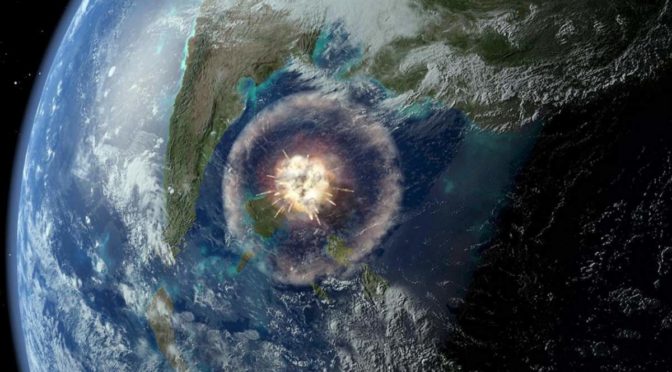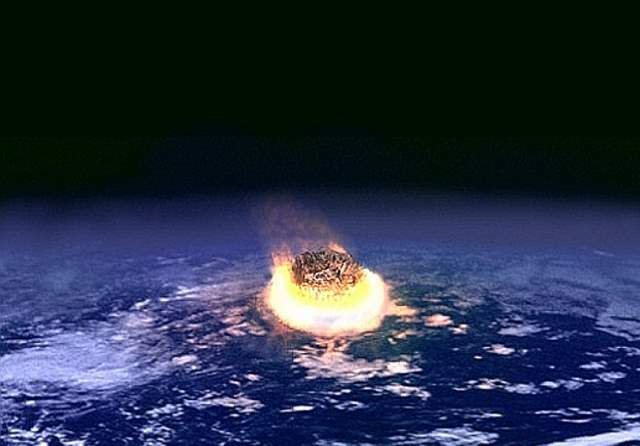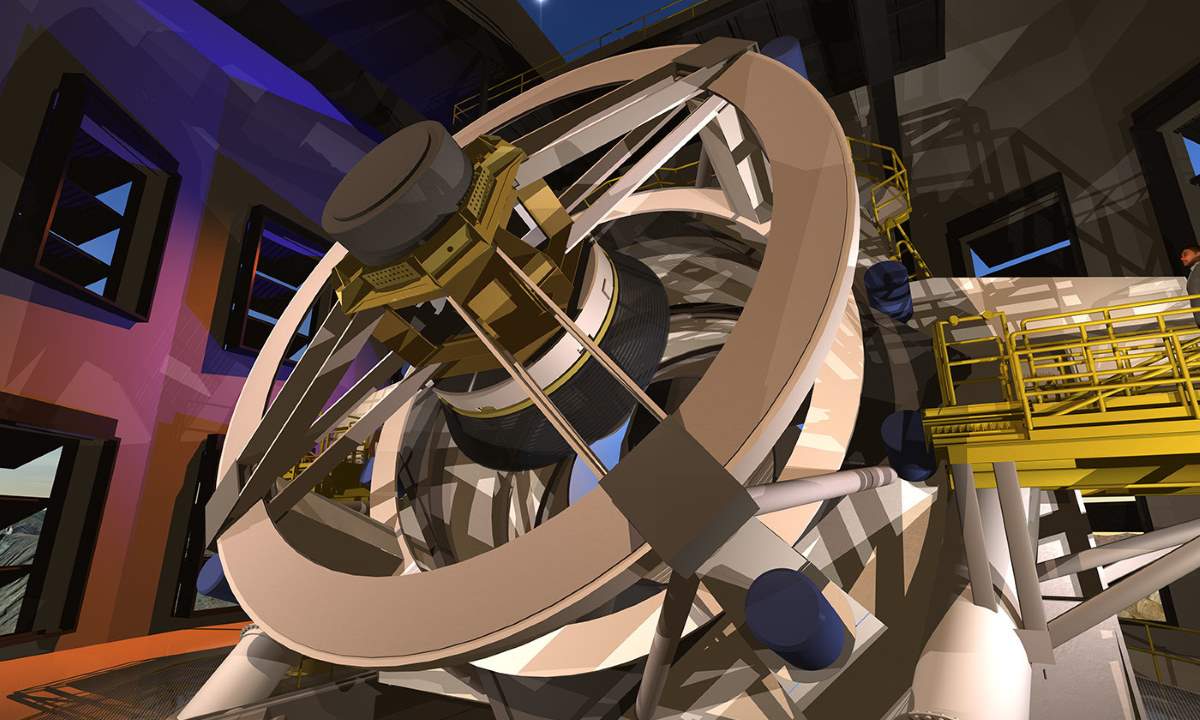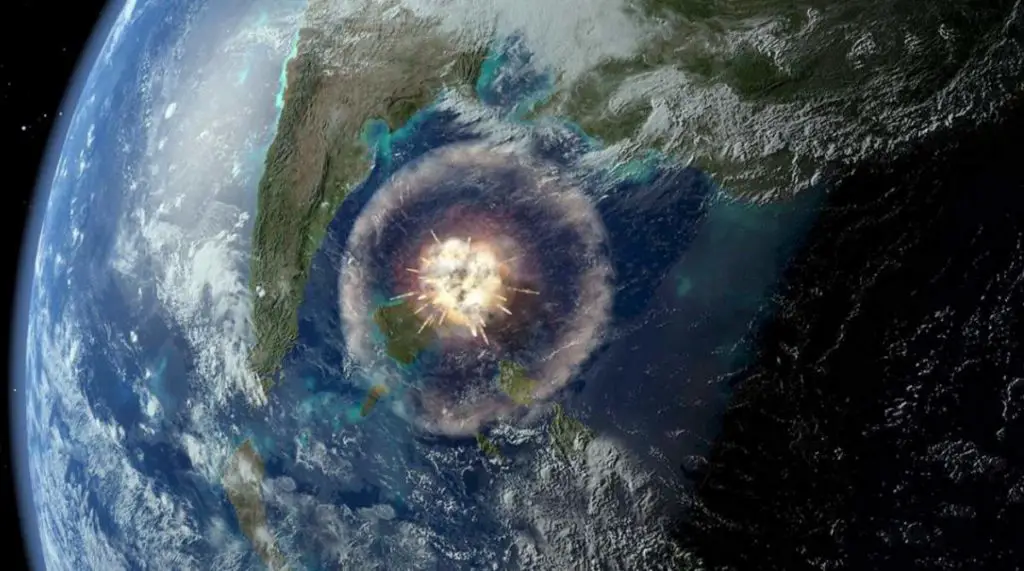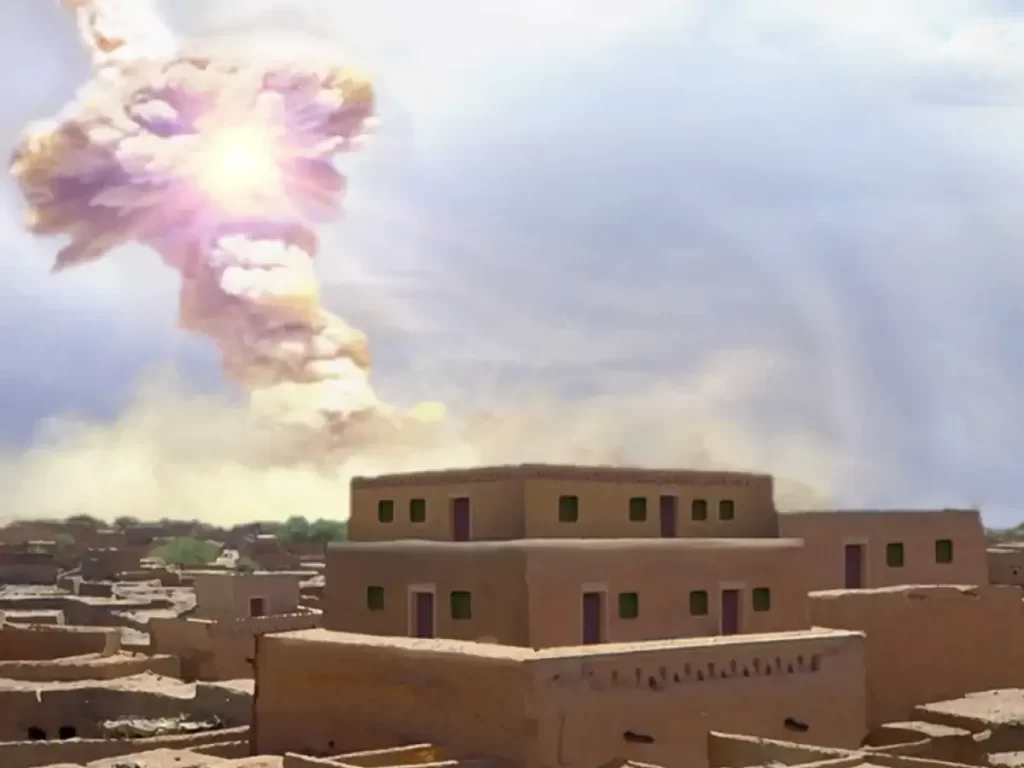Around 66 million years ago, an asteroid (or a comet) with a diameter of at least 10 kilometers (6 miles) impacted a few miles from the present-day town of Chicxulub in Mexico at around 64,000 kilometers per hour (40,000 mph). The impact triggered a chain of events what is known today as the Cretaceous-Paleogene (K-Pg) extinction event, also known as the Cretaceous-Tertiary (K-T) extinction, and wiped out three-quarters of the plant and animal species on Earth, including non-avian dinosaurs
On 15 February 2013, an approximately 20-meter (66 feet) meteoroid (see notes 1) entered Earth’s atmosphere over Russia, with a speed of 19.16 ± 0.15 kilometers per second (60,000-69,000 km/h or 40,000-42,900 mph). Its mass is estimated at 7,000 to 10,000 tons, one of the largest meteoroids that entered Earth’s atmosphere in recent history.
Then, at 9:20 am local time (03:20 UTC), it exploded some 20 to 30 kilometers above the city of Chelyabinsk and created a gigantic fireball (known as a superbolide, see notes 1) brighter than the Sun. An estimated 500 kilotons of energy was released by the explosion.
For comparison, the “Little Boy”, the atomic bomb dropped on the Japanese city of Hiroshima on 6 August 1945 exploded with an energy of approximately 15 kilotons of TNT. So, the Chelyabinsk meteor’s explosion was about 33 times stronger. The shock waves damaged several thousand buildings and injured approximately 1,500 people. No deaths were reported.
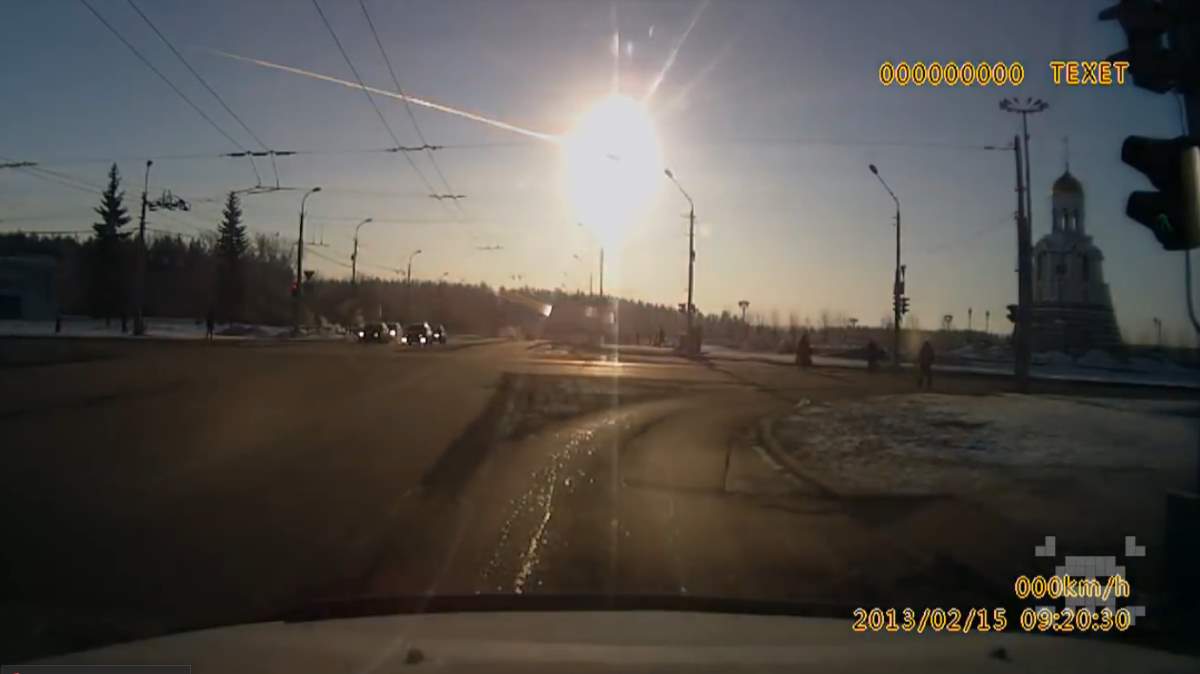
What is worrisome is that no one had any idea this Chelyabinsk meteoroid existed until it entered the Earth’s atmosphere that morning.
Scientists estimate such events occur on average once every 100 years. The most well-known was the Tunguska event, which occurred near the Stony Tunguska River in Yeniseysk Governorate (now Krasnoyarsk Krai), Russia, on the morning of 30 June 1908. It is also the largest impact event on Earth in recorded history. Studies have yielded different estimates of the size of the meteoroid, on the order of 60 to 190 meters (200 to 620 feet), depending on whether the body was a comet or a denser asteroid.
Potentially hazardous objects
A potentially hazardous object (PHO) is a near-Earth object. It can be either an asteroid or a comet. They have an orbit that can make exceptionally close approaches to the Earth and large enough to cause significant regional damage in the event of an impact.
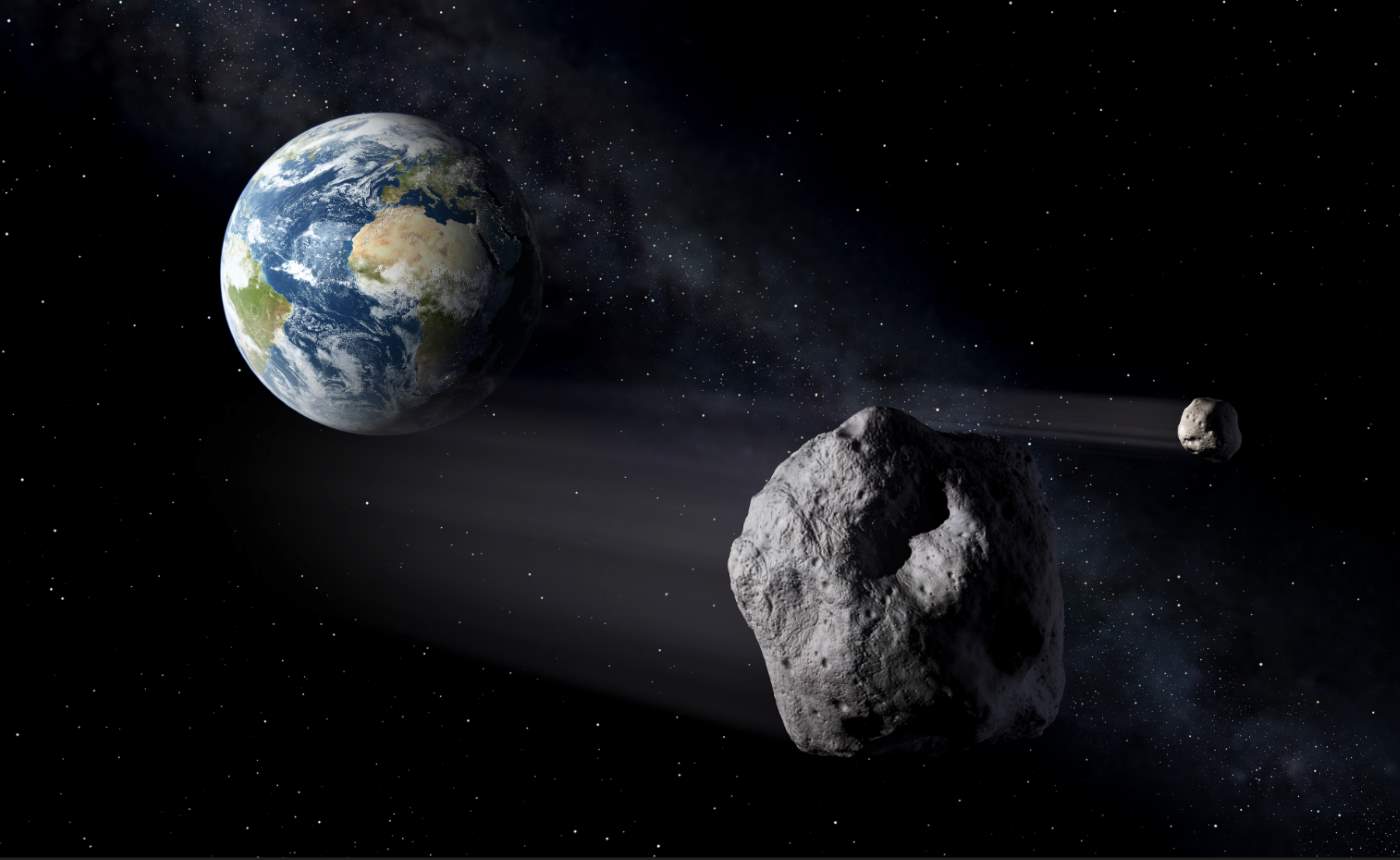
Most of these objects are potentially hazardous asteroids (PHAs), defined as having a minimum orbital intersection distance with Earth of less than 0.05 astronomical units (19.5 lunar distances) and an absolute magnitude of 22 or brighter. As of January 2018, there are 1,885 known PHAs (about 11% of the total near-Earth population), of which 157 are estimated to be larger than one kilometer in diameter.
The animation below, published by NASA Jet Propulsion Laboratory in July 2018, represents a map of the increased count of all known asteroids in the solar system between January 1, 1999, and January 31, 2018. Blue represents near-Earth asteroids. Orange represents the main-belt asteroids between the orbits of Mars and Jupiter.
Large Synoptic Survey Telescope
Finding asteroids that may collide with the Earth in the future is a crucial task. If we detect an asteroid or a comet that is on a collision course hours or days before the possible impact, the Earth won’t have many options.
If, however, we detect these space rocks years or even decades before a potential collision, then we may do something, like using a spacecraft to nudge the body enough to change its path. We still don’t know quite how to do this, though. But there are some proposals for missions like NASA’s DART mission (see notes 2) or ESA’s Asteroid Impact Mission (see notes 3).
To be able to detect the Potentially Hazardous Objects (PHOs) on a collision course with Earth years or even decades before the possible impact, hundreds of scientists are completing the construction of a huge telescope atop a mountain in Chile. It is the Large Synoptic Survey Telescope, a wide-field survey reflecting telescope with an 8.4-meter primary mirror that will photograph the entire available sky every few nights.
The word synoptic is derived from the Greek words σύν (syn “together”) and ὄψις (opsis “view”), and describes observations that give a broad view of a subject at a particular time.
The construction began on April 14, 2015, with engineering first light anticipated in 2019, science first light in 2021, and full operations for a ten-year survey commencing in January 2022.
The Large Synoptic Survey Telescope, unlike almost all previous large astronomical observatories, has committed to making all data public as soon as it is taken. In their words “By providing immediate public access to all the data it obtains, it will provide everyone, the professional and the ‘just curious’ alike, a deep and frequent window on the entire sky.”
Detecting potentially hazardous asteroids is not the only mission of the telescope. The goal of the Large Synoptic Survey Telescope (LSST) project is to conduct a 10-year survey of the sky that will deliver a 200-petabyte set of images and data products that will address some of the most pressing questions about the structure and evolution of the universe and the objects in it. The LSST survey is designed to address four science areas:
- Understanding the Mysterious Dark Matter and Dark Energy
- Hazardous Asteroids and the Remote Solar System
- The Transient Optical Sky
- The Formation and Structure of the Milky Way

The telescope uses a novel 3-mirror design, creating an exceptionally wide field of view, and has the ability to survey the entire sky in only three nights. Images are recorded by a 3.2-gigapixel CCD imaging camera, the largest digital camera ever constructed. The telescope is located on the El Peñón peak of Cerro Pachón, a 2,682-meter-high mountain in the Coquimbo Region, in northern Chile, alongside the existing Gemini South and Southern Astrophysical Research Telescopes.
The software is one of the most challenging aspects of LSST, as more than 30 terabytes of data must be processed and stored each night in producing the largest non-proprietary data set in the world.
Minimoons of Earth
The Large Synoptic Survey Telescope will also be able to detect the “minimoons” of Earth. Minimoons are actually small asteroids that temporarily enter Earth’s orbit. Today, it’s really hard to detect them – in fact, they can only get detected by chance. Scientists spotted the first (and as of August 2018, last) minimoon in 2006, and it was named 2006 RH120.
It is actually a very small NEO (Near-Earth Object), with a diameter of approximately 2-3 meters. It ordinarily orbits the Sun but makes close approaches to the Earth-Moon system around every twenty years, when it can temporarily enter Earth orbit through temporary satellite capture (TSC). Most recently, it was in Earth orbit from September 2006 to June 2007. As a consequence of its temporary orbit around the Earth, it is currently the smallest asteroid in the Solar System with a well-known orbit.
Scientists are now hoping that the LSST will help to detect more minimoons.
Notes
- A meteoroid is a small rocky or metallic body, significantly smaller than an asteroid, in outer space. When a meteoroid (or a comet, or an asteroid) enters Earth’s atmosphere at a speed typically in excess of 20 km/s (72,000 km/h; 45,000 mph), aerodynamic heating of that object produces a streak of light, both from the glowing object and the trail of glowing particles that it leaves in its wake. This phenomenon is called a meteor. If a meteor survives its passage through the atmosphere to reach the surface of a planet or moon, it’s called meteorite. If a meteor is extremely bright, then it’s called bolide. One definition describes a bolide as a fireball reaching an apparent magnitude of −14 or brighter – more than twice as bright as the full moon. A superbolide is a bolide that reaches an apparent magnitude of −17 or brighter A superbolide can be brighter than the Sun, which has an apparent magnitude (m) of -26.74. The apparent magnitude (m) of a celestial object is a number that is a measure of its brightness as seen by an observer on Earth.
- Double Asteroid Redirection Test (DART) Mission is directed by NASA to the Johns Hopkins University Applied Physics Laboratory (JHU/APL) with support from NASA centers: the Jet Propulsion Laboratory (JPL), Goddard Space Flight Center (GSFC), and Johnson Space Center (JSC). DART will be the first demonstration of the kinetic impact technique to change the motion of an asteroid in space. The DART mission is in Phase B, led by JHU/APL and managed by the Planetary Missions Program Office at Marshall Space Flight Center for NASA’s Planetary Defense Coordination Office.
- The Asteroid Impact Mission (AIM) is a candidate mission currently undergoing preliminary design work (phase B1). Launched in October 2020, AIM would travel to a binary asteroid system – the paired Didymos asteroids, which will come to a comparatively close 16 million km to Earth in 2022. The 800 m-diameter main body is orbited by a 170 m moon, informally called ‘Didymoon’. This smaller body is AIM’s focus: the spacecraft would perform high-resolution visual, thermal and radar mapping of the moon to build detailed maps of its surface and interior structure.
Sources
- “New telescope will scan the skies for asteroids on collision course with Earth” on The Conversation
- Large Synoptic Survey Telescope official website
- Large Synoptic Survey Telescope on Wikipedia
Potentially hazardous object on Wikipedia- Double Asteroid Redirection Test (DART) Mission on NASA.gov
- Asteroid Impact Mission (AIM) on European Space Agency website
- “Can a New Telescope Spot Earth’s Evasive Minimoons?” on Popular Mechanics
- “Earth Has ‘Minimoons,’ and They May Solve Asteroid Mysteries” on Space.com
- 2006 RH120 on Wikipedia
- Budget of NASA, Year by Year [1980-1989] - June 10, 2024
- Budget of NASA, Year by Year [1970-1979] - June 10, 2024
- Budget of NASA, Year by Year [1958-2024] - June 10, 2024
